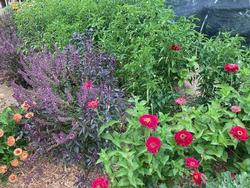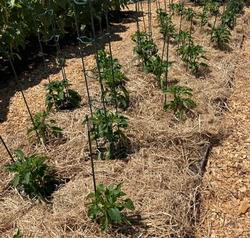Fall 2023
A Season in Review
by Janet Miller
The end of the main growing season is approaching, and what a season it has been, both at the Walnut Creek demonstrating garden, ‘Our Garden’ ) and in our own gardens. In comparison with other winters in our part of the country, this winter was particularly long, wet, and, cold. Here in the Bay Area, we saw record-breaking amounts of rainfall, heavy winds, overcast skies, and unusually cold weather that lasted at least a month longer than usual. All of which spelled trouble for farmers and backyard growers alike. The cold spell meant the soil didn’t warm as quickly as it should have and overcast skies minimized photosynthesis, keeping seedlings small and, in some cases, permanently stunted.

Farmers have always been at the mercy of the weather, and our changing climate will continue to bring new and unpredicted challenges. The best we can do is learn from each of these seasons in order to be better prepared for the next. We are aware that we can still get high temperatures in the fall, and another rainy winter is being predicted. Therefore, we’d like to share some ideas to help you prepare for challenging weather patterns.
Fall

- Mulch new plantings with straw or compost to moderate soil temperatures.
- Don’t leave beds empty during the winter; if not planting edible crops, plant a cover crop such as
- fava beans, field peas, or vetch for nitrogen;
- daikon for deep root penetration of heavy soil;
- mustard to suppress soil-borne pathogens;
- winter oats or wheat for deep root penetration;
- and habitat for beneficial insects.
All of these sustainable garden practices will improve drainage in the soil, which is important when rainfall is heavy, and have the additional benefit of feeding the microorganisms necessary to make plants grow.
Tender cool season crops such as lettuce and peas can withstand some frost when covered with a light frost cloth, draped on a frame (not directly on plants).
Spring

- Avoid working the soil when rainfall has been heavy and the soil is too wet; this would damage soil tilth and break up colonies of microorganisms. Wait for dryer weather when the soil is damp but not dry.
- Always grow something! Plant cool-season vegetables, such as leafy greens, onions, peas,s and short-season broccoli. Replace crops that have overwintered in February and March. These tend to mature rather quickly and will be ready in time to enable sowing warm-season crops.
- Wait to plant warm-season vegetables until soil temperatures reach 60 degrees and nighttime temperatures are above 50 degrees; there is no benefit when planting earlybut plenty of risk! Seedlings should be healthy and at least 6” tall before planting.
- Plant intensively, in a grid pattern rather than rows so that less soil is exposed to heat, wind, and water erosion.
 Courtesy Greg Letts.
Courtesy Greg Letts. - Mulch new plantings with straw or compost to moderate soil temperatures.
- Set up a simple framework for draping shade cloth in the event of extreme heat. Have shade cloth on hand; it should be rated to block no more than 50% of UV rays.
- Water consistently; don’t wait for plants to show signs of wilting.
Useful links
Managing Common Diseases and Pests in your Home Orchard, CCCLib webinar by Terry Lippert
https://www.youtube.com/watch?v=wcBDY83SAfk
Link to fall/winter tasks
https://ccmg.ucanr.edu/SeasonalChecklists/Fall/
And here are some more resources on Fall/Winter gardening tasks
and a link to a great webinar by Terry Lippert, hosted by the Contra Costa County Library:

